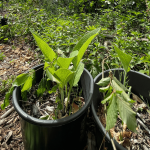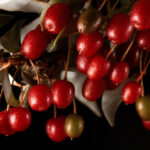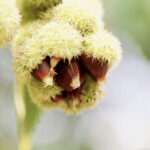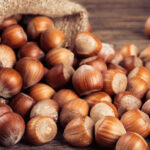Plant Profile: Comfrey – The Dynamic Perennial for Sustainable Gardens
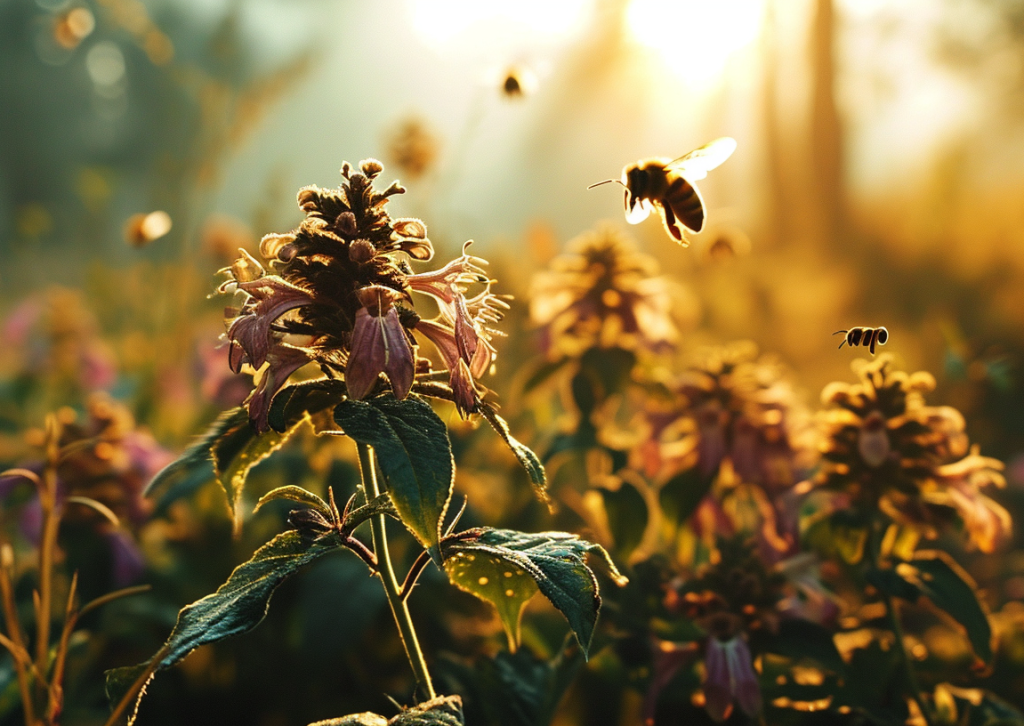
Comfrey, scientifically known as Symphytum officinale, is a perennial herb renowned for its versatility in gardens. Also known as knitbone or boneset, this plant has a long history in both cultivation and herbal medicine.
Classification
- Kingdom: Plantae
- Order: Boraginales
- Family: Boraginaceae
- Genus: Symphytum
- Species: S. officinale
Origin and Distribution
Originally from Europe and Asia, comfrey has spread to many parts of the world. It’s now commonly found in North America, thriving in moist, grassy places.
USDA Hardiness Zones
Comfrey is hardy in USDA Zones 3 through 9, showing a wide range of climate adaptability.
Chill Hours Requirement
Comfrey seeds require a winter chilling period, known as stratification, to germinate effectively. This chilling period can be quite lengthy, and it’s common for gardeners to wait up to two years after sowing the seeds before seeing signs of germination. Due to this extended germination period and the need for a winter chill, many gardeners prefer using alternative methods of starting comfrey, such as live root cuttings.
Rooting for Growth: Bocking 14 Comfrey Cuttings Ready for Planting
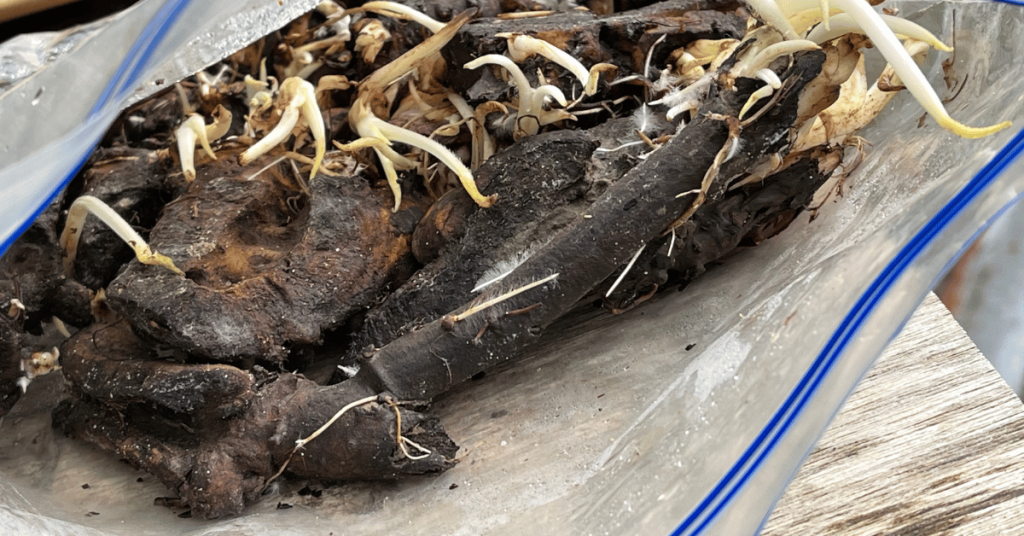
Growth Habits:
- Height: 2-3 feet (60-90 cm)
- Width: 2-2.5 feet (60-75 cm)
- Growth Rate: Fast-growing
- Preferred Conditions: Moist, well-drained soil; partial to full sun.
Role in a Food Forest
Found in the herbaceous layer, comfrey is often used as a ‘chop and drop’ mulch due to its fast growth and nutrient-rich leaves.
Benefits for Hugelkultur or Permaculture Systems:
Comfrey’s deep taproots excel in nutrient cycling, a trait that is especially beneficial in hugelkultur and permaculture. By mining the subsoil for minerals, Comfrey brings up nutrients like potassium, accessible in its foliage. As a ‘chop and drop’ mulch, Comfrey leaves decompose to enrich the topsoil, improving its fertility and structure—critical for sustainable planting methods. Sterile varieties like Bocking 14 and Bocking 4 ensure controlled growth, preventing unwanted spread. These characteristics make Comfrey an indispensable component in permaculture design, supporting soil health and plant diversity.
For more in-depth insights on Comfrey’s role in sustainable agriculture:
Culinary and Medicinal Uses:
Historically used for wound healing, though modern use is generally limited to topical applications due to potential toxicity if ingested.
Cultural Significance
Comfrey has been used in traditional medicine for centuries, primarily for bone and skin healing.
Propagation and Care
Propagates easily from root cuttings. Prefers consistent moisture but is tolerant of various soil types. Minimal care once established.
Pests and Diseases
Generally resistant to pests and diseases, although it can be susceptible to comfrey rust in humid conditions.
Harvesting and Storage
Harvest leaves before flowering for best quality. Dry for storage or use fresh.
Plant’s Lifespan
Perennial. Can live and produce for several years.
Cultivating Comfrey Responsibly to Prevent Garden Overrun
Comfrey’s potential for invasiveness is well-documented, especially with varieties that propagate from seed. It can be exceedingly challenging to remove if established, with every fragment of root capable of becoming a new plant. It is recommended to use gloves when handling comfrey due to possible skin irritation and to be aware of its content of pyrrolizidine alkaloids, which have been linked to liver damage and may have carcinogenic effects.
To keep comfrey’s growth under control, one should follow containment practices similar to those used for spearmint. Using tall containers placed on impermeable surfaces can prevent the roots from spreading. Enclosed garden spaces or raised beds with root barriers are also effective strategies to limit comfrey spread and protect your other plantings.
The selection of sterile comfrey varieties, such as Bocking 14 and Bocking 4, is crucial. These cultivars of Russian comfrey are known for their rapid growth without the risk of self-seeding, thereby providing the benefits of comfrey without invasiveness. When planting comfrey, it’s vital to be well-informed about its behavior and to choose practices and varieties that align with sustainable gardening, thus supporting the harmony of your garden ecosystem.
Environmental Impact of Comfrey
Comfrey is not only valued for its nutrient richness but also for its positive impact on the environment. Here are key aspects of Comfrey’s environmental impact:
- Erosion Control: Comfrey’s deep and extensive root system makes it an excellent plant for controlling soil erosion. By binding the soil, its roots prevent the washing away of topsoil during heavy rains, thus preserving soil integrity and promoting healthier ecosystems.
- Preventing Spread of Invasive Plants: Comfrey can be strategically planted to help control the spread of certain invasive plant species. Its dense growth can outcompete some invasive plants for resources, thereby limiting their spread. This characteristic makes comfrey a valuable ally in maintaining the balance of native plant communities.
- Soil Improvement and Remediation: Comfrey improves soil structure and fertility. Its roots bring up deep-seated nutrients, making them available to other plants. This nutrient cycling is crucial for maintaining fertile soils, especially in organic farming systems.
- Supporting Biodiversity: Comfrey attracts a variety of pollinators, including bees and butterflies, with its flowers. This makes it an important plant for supporting biodiversity in gardens and agricultural landscapes.
- Carbon Sequestration: Like many perennial plants, comfrey plays a role in carbon sequestration. Its growth helps in capturing atmospheric carbon dioxide, storing carbon in its biomass and contributing to the mitigation of climate change.
- Natural Fertilizer and Compost Activator: As a natural fertilizer, comfrey provides essential nutrients to the soil without the need for chemical fertilizers, thus reducing the environmental footprint of gardening and farming. It also acts as a compost activator, speeding up the decomposition process and enhancing compost quality.
- Water Conservation: Comfrey’s deep roots make it relatively drought-resistant, reducing the need for frequent watering. This trait is particularly valuable in areas facing water scarcity and in sustainable landscaping practices.
By integrating comfrey into agricultural and gardening practices, we can leverage its environmental benefits, contributing to more sustainable and ecologically sound land management.
Wildlife Attraction
It attracts pollinators like bees and provides a habitat for beneficial insects.
Companion Planting
Works well with fruit trees and bushes, providing mulch and drawing up deep nutrients.
Fun Fact: Comfrey’s Nutrient Richness
Comfrey is not just known for its medicinal properties but also for its remarkable nutrient content, particularly in its leaves. Here are some fascinating facts about comfrey:
- Rich in Essential Nutrients: Comfrey leaves are abundant in key nutrients like nitrogen, phosphorus, and potassium. These elements are crucial for plant growth, making comfrey an excellent natural fertilizer.
- Deep Nutrient Mining: Thanks to its deep taproot, comfrey can access nutrients from the subsoil layers, which are typically out of reach for many other plants. This ability allows comfrey to accumulate a high concentration of nutrients in its leaves.
- Correlation with Soil Quality: Research indicates that the nutrient content in comfrey, especially nitrogen, phosphorus, and potassium, is directly correlated with the levels of humus, mobile phosphorus, and exchangeable potassium in the soil. This information comes from a study titled “Ecological Characteristic and Chemical Composition of the Aboveground Mass of Symphytum L. Species of the Flora of Kabardino-Balkaria Republic,” available here (note: the article is in Russian).
- Environmental Influence on Vitamin C Content: The amount of vitamin C accumulated in comfrey plants is influenced by environmental factors such as altitude, average temperature, and rainfall during the growing season.
- More Potassium than Manure: Interestingly, comfrey has been found to contain more potassium than composted manure, making it a superior choice for potassium supplementation in gardens.
- Versatile Usage: Apart from being used as a fertilizer, comfrey has historical significance in traditional medicine, particularly for its healing properties in bone and skin ailments.
References and Further Reading:
- “Comfrey: A Clinical Overview” – Journal of Ethnopharmacology
- “Comfrey in Permaculture” – Permaculture Magazine
For more detailed and scientific information, these sources can provide an excellent starting point.
Discover More: Stabilize Your Landscape with the Right Plants
If you’ve found the information about comfrey’s environmental impact intriguing, you might be interested in exploring further how plants can be used for erosion control and landscape stabilization.
Plants for Erosion Control: Stabilizing Your Landscape is an insightful article that delves into various plants, including comfrey, that are effective in preventing soil erosion and maintaining landscape integrity. This resource is particularly valuable for gardeners, landscapers, and environmental enthusiasts looking to adopt more sustainable practices in their outdoor spaces.
Whether you’re dealing with a sloping garden, a riverside property, or simply want to enhance the ecological health of your land, this article offers practical tips and a wealth of information on choosing the right plants for erosion control. Dive into the article to learn more about how you can make a positive impact on your environment today!

